Munich's art museum houses one of the most important collections in Europe on two floors of a large neo-classical building. Roughly 700 paintings are on display, featuring the work of many of the greatest European artists from the 14th to the 18th centuries. Highlights include works by Dutch and Flemish masters, as well as the Italian masters such as Botticelli, Raphael and Titian. Famous masterpieces in the permanent collection include Rembrandt's 'Self-Portrait' (1629), Raphael's 'The Canigiani Holy Famliy' (1505), Guido Reni's 'The Assumption of the Virgin' (1642), and Francois Boucher's 'Portrait of the Marquise de Pompadour' (1756). The gallery is massive, consisting of dozens of rooms, and requires a great deal of time to explore thoroughly. Bags and handbags are not allowed in the museum but there are storage facilities. Photography is allowed but only without a flash. There is a restaurant at the museum.There are actually three art museums in the location and you can get a discounted rate if you plan to visit all of them in one day.
Address : Barerstrasse 27
Website : www.pinakothek.de
Transport : Tram - No 27 to Pinakotheken; U-Bahn - U2: to Königsplatz or Theresienstrasse; Bus - No 154 to Schellingstraße
Opening times : 10am - 6pm daily; 10am - 8pm on Tuesdays, closed on Mondays
Admission : €7 regular entry. Free for children under 18.
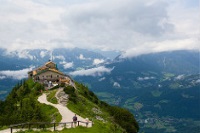
The name Berchtesgaden is most closely associated with Adolf Hitler's country house, but it is in fact a delightful Bavarian alpine village with ancient winding streets and a medieval marketplace, popular as an excursion from Munich. Hitler's holiday house, the Berghof, is actually at Obersalzberg about half a mile (2km) up the Kehlstein Mountain. Afternoon bus tours to the Fuhrer's playground can be undertaken from the tourist office in the village, but there is little to see besides some underground bunkers, which are open to the public. Most tourists, however, do delight in visiting the Kehlsteinhaus (or Eagle's Nest), a remarkable building perched precariously atop the mountain, originally commissioned by Martin Bormann as a 50th birthday present for Hitler (although the notorious Nazi leader seldom visited it because of his fear of heights). Today it is the site of an excellent Bavarian restaurant and provides breath-taking views at the end of a stunning winding mountain road.The town of Berchtesgaden itself has some interesting attractions, besides its 16th-century architecture and enticing inns. There is a small wood-carving museum at Schloss Aldelsheim which can be viewed on a guided tour. Wood sculptures, Renaissance furniture and some art works are worth seeing at the Konigliches Schloss, which was originally an Augustinian monastery. The most fun to be had, however, is in the salt mines to the east of the town, which offer guided tours. Visitors wear protective clothing and ride on wagons to the mine, then explore the mine on foot and ride miner's slides, finishing with a trip on the salt lake ferry. The mine has been in operation since 1517. Berchtesgarten also boasts a world-class ice-skating rink, the Eisstadion, which is sought after by winter sports enthusiasts in the winter months, along with the skiing opportunities in the surrounding area.
Website : www.berchtesgaden.com
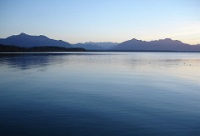
One of the most beautiful lakes in the Bavarian Alps, Chiemsee boasts two islands and is lined with resorts. A popular weekend excursion in Germany, it can be reached by train from Munich in an hour, or by road via the A8 Autobahn. Visitors can take a steamer cruise around the lake from Prien on the west shore to explore the islands in the lake. The scenery is breathtaking and in summer there is great swimming and sailing to enjoy. Even in winter the lake is beautiful, and much less crowded.Frauenchiemsee is the smaller island and the site of a quaint fishing village with some colourful traditional customs, and a Benedictine nunnery known for its liqueur. The larger island, Herrenchiemsee, bears one of King Ludwig's famous fairy-tale castles. This one was never completed, but was intended to be a replica of the palace of Versailles. The centre of the palace still stands, complete with a splendid hall of mirrors and surrounded by gardens and woodland. It is an extremely popular tourist attraction with its gaudy splendour and picturesque location.
Website : www.chiemsee.de
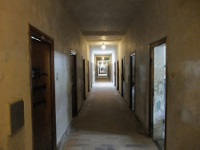
About 10 miles (16km) to the northwest of Munich on the Stuttgart Autobahn is the town of Dachau. Once a quiet artists' community, it became the site of the first notorious Nazi 'death camp', where thousands of perceived enemies of the Third Reich were imprisoned, starved, and killed between 1933 and 1945. The camp has now been turned into a memorial museum to the prisoners (67,000 were liberated alive by the US Army on April 28, 1945). The museum contains three memorial chapels. The Lagerstrasse, the main camp road, still exists, lined with poplar trees, but only two of the original 32 barracks that lined it remain, having been rebuilt to illustrate the conditions endured by the prisoners. The original kitchen, laundry and shower block is now a museum containing exhibits, photographs and documents depicting the persecution of Jews and other prisoners. The exhibitions are often very personal and include the accounts and stories of prisoners. The memorial is a sobering experience, and may not be suitable for young children.
Address : Alte Römerstraße 75, Dachau
Website : www.kz-gedenkstaette-dachau.de
Telephone : (0)8131 66 99 70
Transport : From Dachau train station take bus 726 to the main entrance of the Memorial Site. S2 train from Munich
Opening times : Memorial/Museum open daily 9am to 5pm; Library and Archive available by appointment only between 9am and 5pm Tuesday to Friday.
Admission : Free. Small charges apply for audio guides and guided tours.
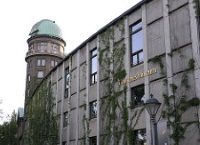
The Deutches Museum is a great stop for families exploring Munich. It is the world's largest technology and science museum, with roughly 28,000 artefacts on display in exhibits dedicated to themes like Energy, Transport, Natural Science, Communications, Musical Instruments and New Technologies. The museum is located on a small island in the Isar River, with additional facilities outside of Munich and in Bonn.There is a section especially dedicated to children which is called Kid's Kingdom and features 1,000 fun, interactive activities including things like a giant guitar to be played, enormous building blocks, and a fire department. It is aimed at kids aged three to eight and all children must be accompanied by an adult. For the grown-ups there is a wealth of interesting information and exhibitions on topics like astronomy, chemistry, pharmaceutics, electricity, computers, microelectronics, hydraulic engineering and astronautics. The museum is designed to be accessible and entertaining and even those who have little understanding of technology and science should be enthralled.
Address : Museumsinsel 1, Munich
Website : www.deutsches-museum.de
Telephone : (0)89 2179 333
Transport : U-Bahn - Line 1 +2, Fraunhoferstrasse; Bus - Line 132, Boschbrücke
Opening times : 9am to 5pm daily.
Admission : Adults €12; schoolchildren/students €4
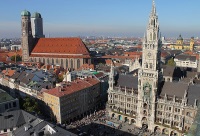
The Marienplatz is the heart of Munich and the site of its most important historic buildings. The square is dominated by the Neo-Gothic Town Hall featuring its famous Glockenspiel, both built in the 19th century, although they look authentically Gothic. The Glockenspiel delights visitors when it chimes the hours every day at 11am, 12pm and 5pm with its 43 bells, accompanied by moving clockwork figures that display vignettes from Munich's history. The Town Hall has a tower that can be accessed by a lift and from the top you get wonderful views of the city.The centre of the square, once a vibrant farmer's market, features a statue of the Virgin Mary after which Marienplatz was named. Visitors can also explore a toy museum in the Old Town Hall on the square, and the Frauenkirche, Munich's cathedral, dating from the 15th century. The square is full of great shops and pleasant outdoor eating areas where you can sit under trees, refuelling, and watch the world pass by. The Marienplatz is still a social gathering place for locals, just as it has been throughout its long history, and although it can get a bit crowded it is an un-missable attraction in Munich, and a must for photographers.
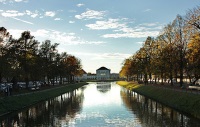
About five miles (8km) from the city centre, accessible by tram and bus, is the interesting Schloss Nymphenburg, originally a summer home for Munich aristocracy. The palace has been expanded, altered and fitted with various eccentricities by succeeding owners over the centuries since building began on it in 1664. Today it is a delight for tourists who revel in exploring the villa and grounds. Inside there are some interesting frescoes in the main hall. An arcaded gallery features a collection of 36 provocative paintings ordered by King Ludwig I showing the most beautiful women of his day. The surrounding park has some surprises too, with some interesting pavilions hidden among the English-style gardens. There are also collections of Ludwig's elaborate coaches on display, and a porcelain museum. There is information provided in the palace on its history but there are also audio guides available which greatly enrich the experience. Although you have to pay to enter the palace you can wander around the lovely grounds for free.
Address : Eingang 19
Website : www.schloesser.bayern.de/englisch/palace/objects/ny_schl.htm
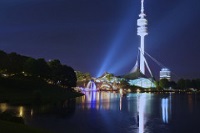
Munich's massive Olympiapark complex was constructed for the 20th Olympic Games in 1972, but remains a marvel of modern engineering. Its main stadium is like an enormous tent, which can seat close on 70,000 spectators, and is topped by one of the largest roofs in the world, extending for 720,000 square feet (66,890 sq metres) and made of tinted acrylic glass. The roof collects rainwater which is used to fill the adjacent Olympic lake. Tent roof tours (with or without an abseiling option) are on offer. Visitors to the site can enjoy a spectacular view from the revolving restaurant and observation terrace which tops the 950-foot (290m) high Olympic Tower. Near the tower is the BMW Museum, which displays the history of Germany's famous automobile manufacturer and is in itself a popular attraction. Far from being a remarkable 'white elephant', the Park is still in constant use not only by tourists but by locals who use it as a lively leisure and recreational centre in the city. On more than 200 days of the year it is the venue for rock and pop concerts, sports events, exhibitions and trade fairs. Check the website to see what's happening at the venue during your stay.
Address : Spiridon-Louis-Ring 21
Website : www.olympiapark-muenchen.de

Travel Guide powered by Word Travels, copyright © 2023 Globe Media Ltd. By its very nature information in this travel guide is subject to change at short notice and travellers are urged to verify information on which they're relying with the relevant authorities. Neither Globe Media Ltd nor Travel Vogue can accept any responsibility for any loss or inconvenience to any person as a result of information contained above.